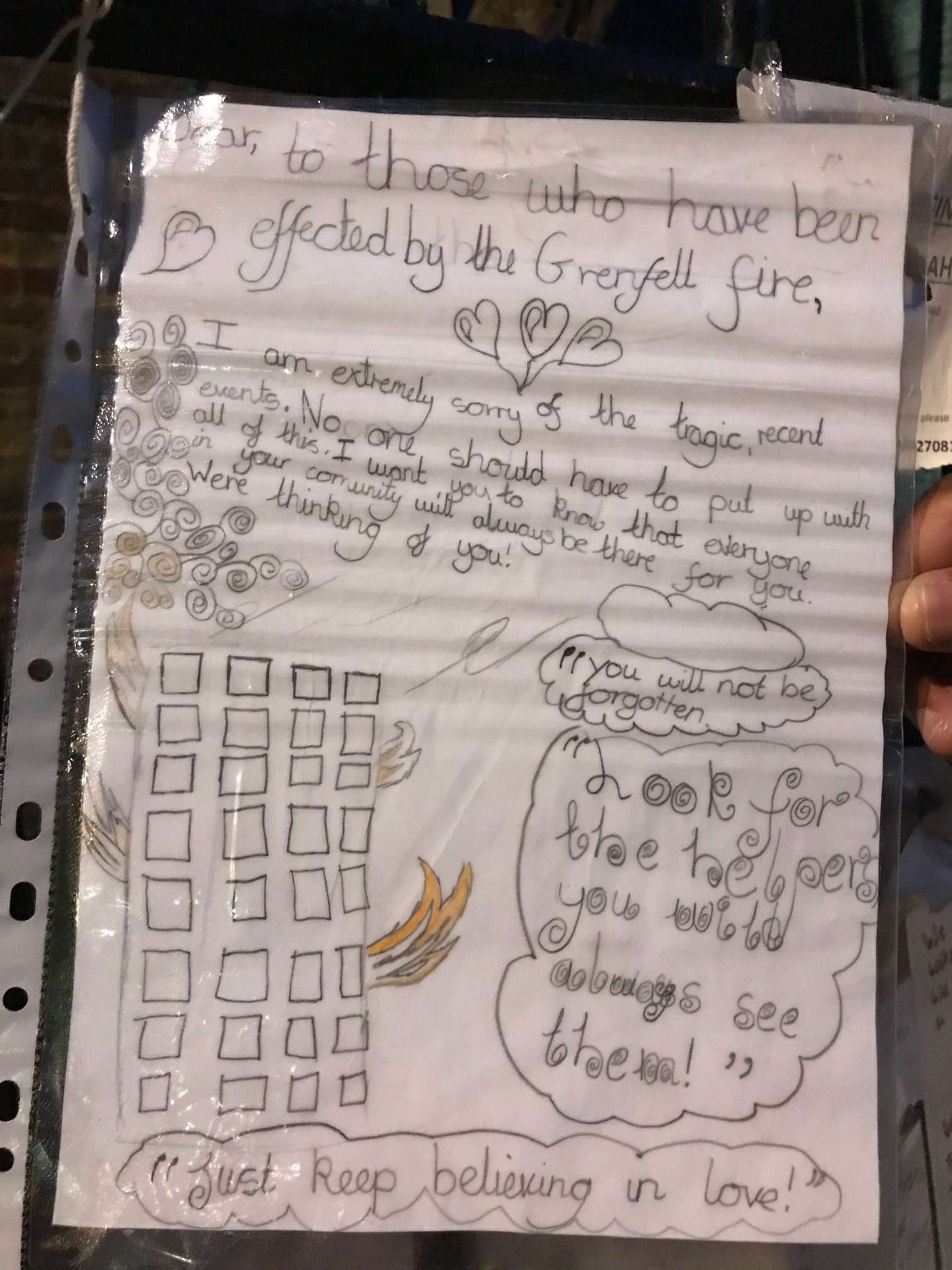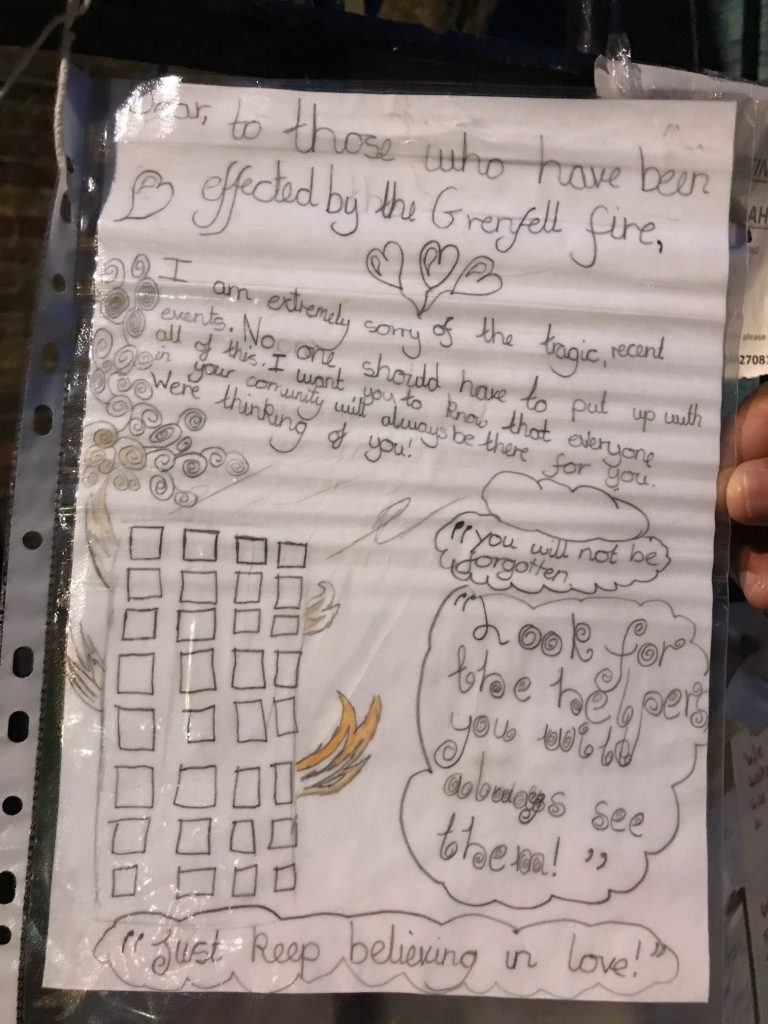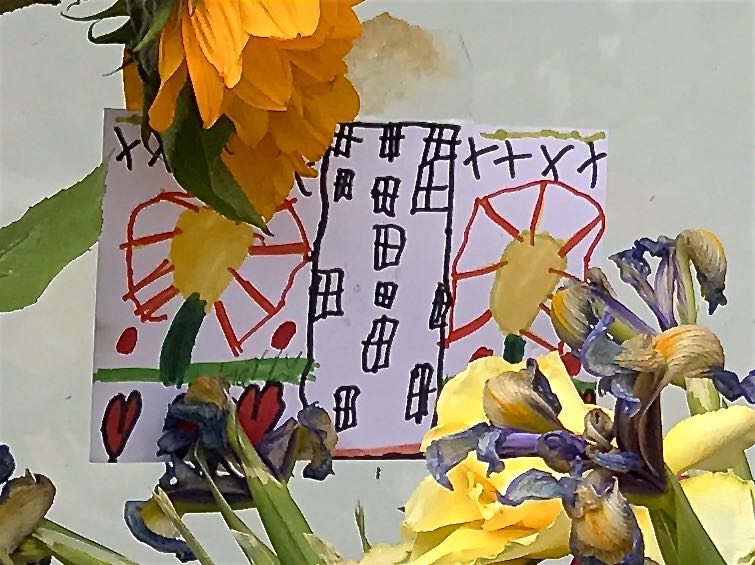
Aftermath: Grenfell Fire

By Paul Coleman
The grisly Grenfell Tower fire is a vicious bandit that steals lives.
Many people who walked these west London streets just a few weeks ago have now perished. But local residents do not yet know exactly how many lives the fire has stolen. The blistered tower grotesquely blackens west London’s skyline and stops people in their tracks as they go about their daily lives. But the scorched and gutted tower still refuses to yield that grim final tally.
Senior coroner Dr Fiona Wilcox is responsible for formal identifying victims of the fire that began and rapidly spread around 01:00 on Wednesday 14 June. In the three weeks after the fire, Dr Wilcox formally identifies 21 people who have died. She informs their families. Police Commander Stuart Cundy says police have forensically transferred the last of 87 visible remains recovered from the tower to the Westminster Mortuary. “I must stress that the catastrophic damage inside Grenfell Tower means that this is not 87 people,” says Cundy. “I cannot say how many people have now been recovered.”
Police speak to at least one resident in 106 of Grenfell’s 129 flats and from this know that people from those flats are dead or missing presumed dead.
But, three weeks after the fire, police remain unable to trace or speak to anyone who lived in another 23 flats spread from the 11th to the 23rd floor. Detective Chief Superintendent Fiona McCormack, a homicide and counter-terrorism specialist, says police do not know for sure exactly how many people were in those 23 flats on the night. McCormack has listened to 26 emergency 999 calls from people who said they were inside one of those 23 flats. Police assume that no one from any of these flats survived.
McCormack says international forensic specialists are involved with the Grenfell investigation. “But the tragic reality is that due to the intense heat of the fire there are some people who we may never identify,” says McCormack.
*
Contain and defuse
Survivors, family, friends and other local residents know the actual death toll will be much higher – and on these streets some people say the authorities are dampening public awareness of this higher death tally in order to contain protest and defuse anger.
For instance, a typed notice on a scrap of paper taped to a brick wall near Ladbroke Grove states: ‘Grenfell Tower. Local estimate 150 Dead including 50 children.’
One local resident, a Londoner of Moroccan origin, says a fire officer friend has said firemen found “about 42 bodies, from children to old people, people who’d been hiding together in one room. He can’t tell the media this as he’d get the sack”.
Even though some Grenfell Tower and Grenfell Walk residents had forewarned of its possibility – even of its inevitability – the Grenfell fire strikes the people of this Latimer Road neighbourhood like a thunderbolt. Some of those who survived and went to hospital now walk these streets in a post-traumatic daze. Other local people in this quiet corner close to Ladbroke Grove and the annual Notting Hill Carnival route, volunteer their visceral shock, grief and anger. Time, if it is a healer, has yet to put in a real shift on these streets.
“Hundreds have died in there,” says a woman who lives on the Lancaster West estate. “The authorities are lying to us, to stop us taking to the streets. They worry about riots.” Wearing a cream hijab and light green tunic, she pauses and stares at an ever-growing carpet of flowers on the steps outside the Notting Hill Methodist Church. Then she quakes and sobs: “I lost my friend in that fire. My daughter used to visit her friend there and sleep over. How can this happen in London, in this century?” Other local women take her to a nearby bench to sit and console her.
“I can’t believe my friends died there,” cries another woman. “I dream about this nightmare every night. We’re not going to let them get away with this.”
*
Painful memory
Eyewitnesses to the fire remain traumatised, many of them women. Tamara, a local resident, recalls: “Several of us ran over to the estate and there were people throwing the kids out of the building and saying ‘just save my children’.”
“I saw a man fly out of his window,” says Samira, another eyewitness. “I saw kids screaming for help and a lot of people jumping out.”
“People jumped,” says a fireman. “A mother threw a baby from a floor high up, caught by a complete stranger just so she could get away her baby away from the fire.”
A young man closes his eyes and puts his hand on his forehead to recall a raw, salted and painful memory. “I saw a kid on fire on the twenty-second floor,” says the young Londoner. “He walked to the window and jumped.”
A frail-looking elderly white woman, a local resident, confronted by the dozens of ‘Missing’ notices, flowers and crayoned children’s drawings of Grenfell Tower, slumps to the pavement. Three women come to her aid and sit with her on the ground to offer comfort.
*
Democratic deficit
Grenfell Tower is part of the Lancaster West council housing estate that has provided generations of working class people with 900 homes since it opened in the mid-1970s. The tower itself housed an estimated 600 people in 129 flats on 24 floors. The Royal London Borough of Kensington and Chelsea council own the estate on behalf of local people. But in the mid-1990s the council pass management of the estate to the Kensington and Chelsea Tenant Management Organisation, a not-for-profit private company with tenant representatives on its board. A long-running saga over many years sees tenants lose any meaningful grip over the company. Grenfell Action Group residents accuse the KCTMO of ignoring their expressed worries about poor fire safety, no sprinklers, inadequate fire safety and a series of power surges that causes small fires in flats. The KCTMO operates with a democratic deficit that will later cost lives – and render many homeless.*
McCormack says the KCTMO provided police with a list of Grenfell Tower residents on the first day of its investigation after the fire. “We quickly identified – by the end of that day – that the list was not accurate,” says McCormack. Investigators take statements from survivors to find out if flats had visitors that night. Local schools and nurseries are asked if children have not attended since the fire. Fast food outlets are asked if they delivered to Grenfell Tower that night.
McCormack fears some people might not be forthcoming with information as they might be worried about their immigration status. A few also might have been illegally sub-letting council flats in the tower – although no evidence of sub-letting is produced. The Director of Public Prosecutions says tenants of Grenfell Tower and Grenfell Walk sub-letting their properties on the night of the fire should not face prosecution for offences under the Prevention of Social Housing Fraud Act 2013.
The government opens a smaller window for people to provide police with information about the fire even if they are worried about their immigration status. The government tells Visa and Immigration Enforcement officers that people ‘directly affected by the fire’ should be granted a temporary period of lawful residence in the UK. This does not apply to relatives of those affected by the fire. This short-term policy will cease on 31 August 2017. “I do not want there to be any hidden victims of this tragedy,” says police commander Stuart Cundy.
*
Souls
The police’s forensic operation might last until the end of 2017. But the truth looms that traumatised local people may never precisely know how many perished in that middle-of-the-night larceny. Londoners across this anxious city are already disorientated by cruel terrorist attacks at Westminster, London Bridge/Borough Market and Finsbury Park. Normal life is yet to be resume. But many know that the Grenfell investigation bears more than just a passing resemblance to the aftermath of the destruction of the twin towers of the World Trade Centre in New York. The remains of 40% of the 2,753 people who perished in that attack by hijacked aircraft in September 2001 were never identified or even found.
Seven days after the fire, a local North Kensington resident, Pauline, flicks through the pages of book of condolence placed on a table outside Notting Hill Methodist Church. Pauline neatly and reverentially adds her own words to the book: ‘I can’t even imagine what you were all going through, watching it from my window I felt so helpless. Every single one of you are so courageous and for those that didn’t make it God truly bless your souls.
RIP. With deepest love, Pauline x.’
*
* Prime Minister Theresa May self-imposes a deadline of three weeks after the fire for government and the council to rehouse survivors and residents who have lost their homes. The government makes 139 offers of alternative accommodation but only nine such offers are accepted.

*
© London Intelligence. All Rights Reserved.
